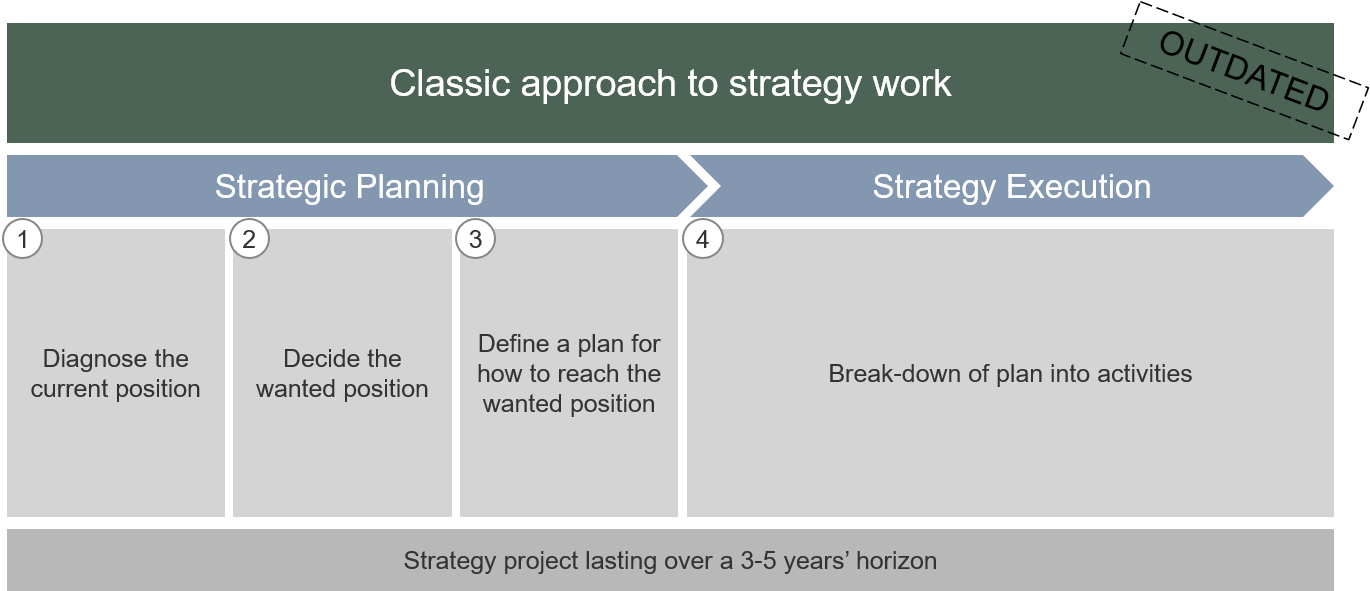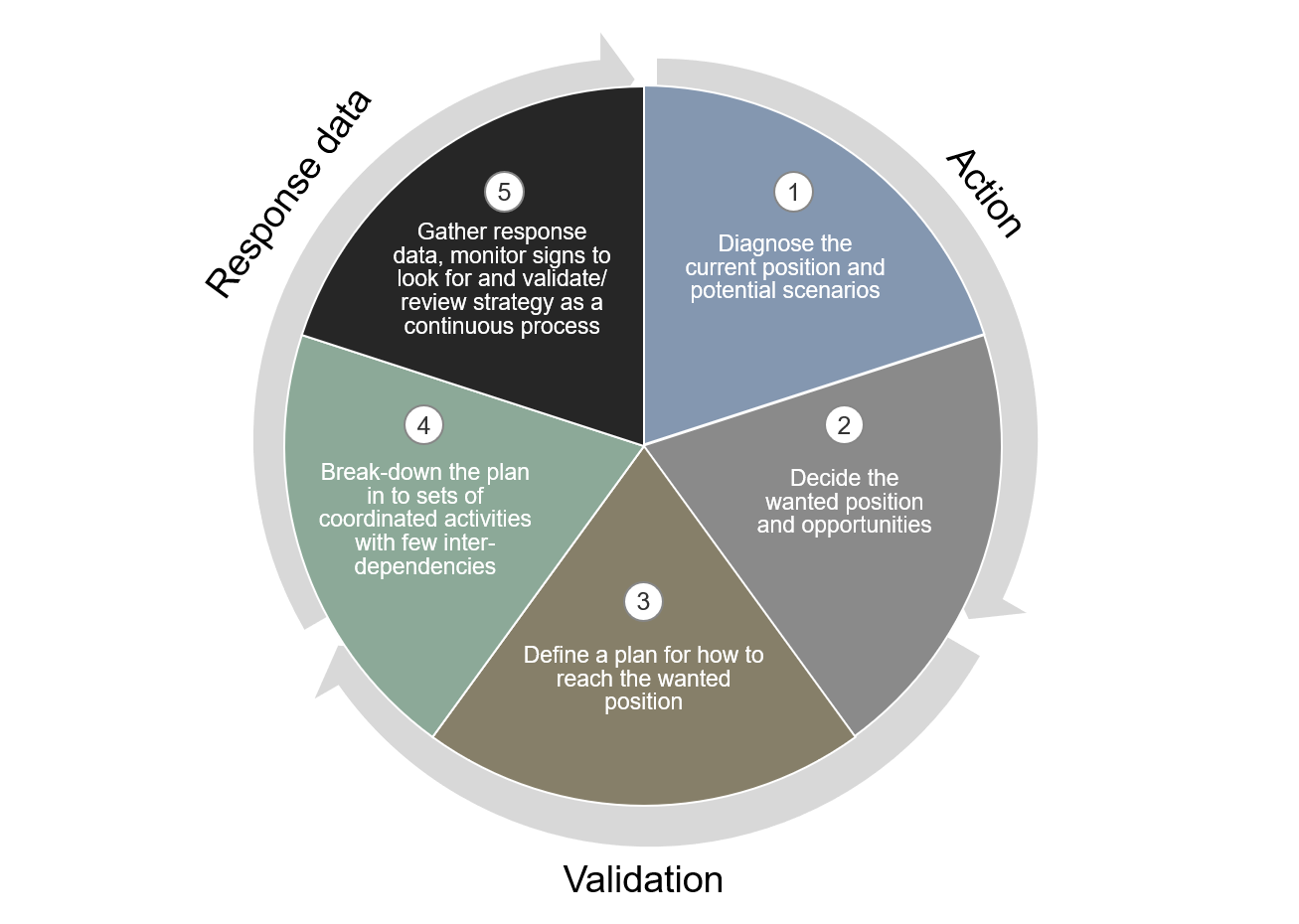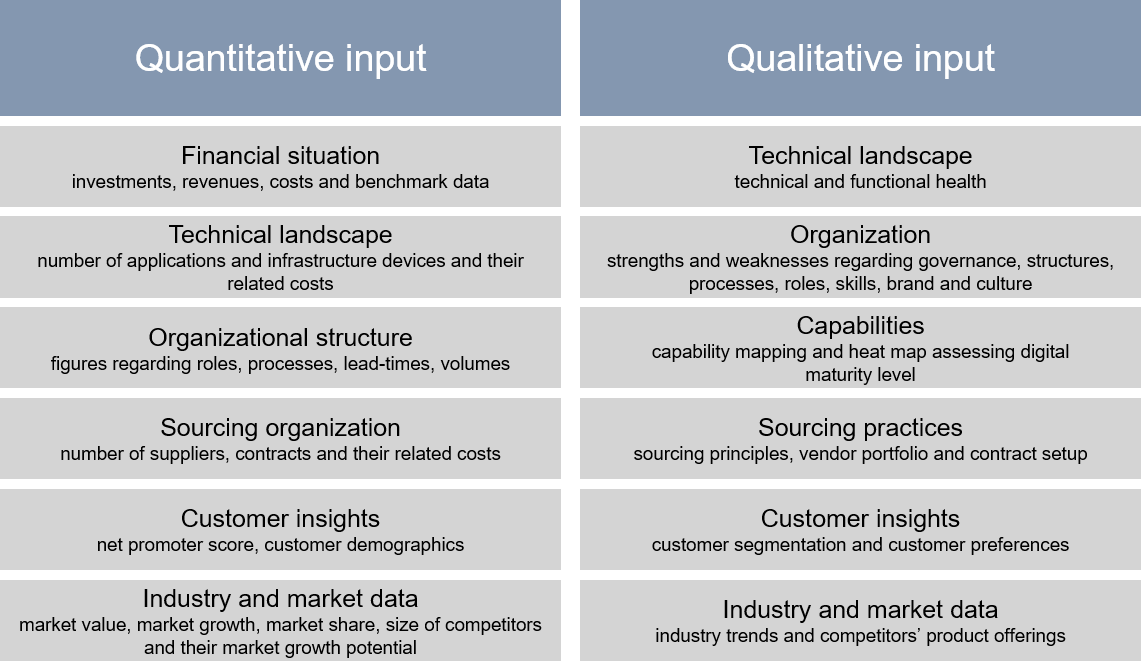Customers do not wait for your strategic changes to be operationalized
Recent unexpected events, that we never could have been prepared for, have brought flexibility and agility even more to the agenda. Companies are struggling to respond to the evolving use of technology and market changes, and they have finally understood how little time there is to address these changes. The organizations of the future have been able to cope with the changed landscape while the more traditional organizations have struggled to adapt themselves in the new environment. To be able to acclimate to a new reality where consumer behaviors, supply chains, employee needs, as well as legal and government requirements play an important role, companies must consider strategy development as part of their operating business. Again, market changes do not wait for the next strategic planning cycle. If your organization does not change accordingly in time, it may be too late and the rivals in the marketplace will gain advantages and steal your market shares. Therefore, there is a need to replace the classic strategy project to an iterative strategy process with faster feedback loops. In this article, we will present an iterative strategy framework that enables you to cope with the ever-changing environment.
The classic strategy project and its criticism
Generally, the classic strategy project include both strategic planning and strategy execution. The strategic planning usually consists of a current state diagnosis, a strategic agenda describing the wanted position and a plan of how to transform and reach the wanted position. Strategy execution usually includes a break-down of the plan into activities placed in a roadmap.
 Figure illustrating the outdated classic approach to a strategy project
Figure illustrating the outdated classic approach to a strategy project
This kind of classic strategy project has traditionally lasted over a 3-5 years’ time horizon; however, executives criticize the process for being bureaucratic, insufficiently insightful, non-continuous and ill-suited for today’s fast-changing environment. Strategy as a project, instead of part of operations, is also criticized for being an outdated artifact. Companies that seek to prosper need to invest in market intelligence and adopt organizational structures and processes, enabling speed and responsiveness to market changes. We have seen this in several cases and are strong supporters of this criticism.
The strategy work must become an iterative process
In our view the current position, the wanted position and the journey toward the wanted position cannot be considered as the truth during the 3-5 year period of no strategical work. Especially, when we have an environment that will continuously challenge whether the current position have changed or whether the wanted position is reasonable. Of course, companies need to make decisions and invest in what they at the moment believe is the best opportunity forward. However, there are mechanisms that can be used to ensure that you continuously monitor the “what ifs†in the operating environment.
Let us visualize this with an example.
A company decided to further invest in a specific commerce platform. The decision was based on a set of different parameters which all were true at the time being. In this case, one of the most important parameters was the high probability that most customers wanted to interact via their retailers instead of with the company itself. Suddenly, and over a short period of time, the customers’ preferred interaction channel changed drastically. The earlier truth was now considered as false and the company struggled to decide whether and how to re-think the investment…
In a perfect world, before the investment was made, the company should have identified this scenario (of customers preferring another interaction channel) but they should also have identified additional potential scenarios. Moreover, they should have begun monitoring all these potential scenarios and their parameters. Examples of parameters are the scenario’s impact on the company, its probability of occurring, the time horizon during which it potentially will occur, signs to look for, and potential investments and opportunities related to the scenario. Monitoring of the scenarios’ signs to look for should have been started even if their probability of occurring was estimated as low, since the monitoring can indicate that some of the parameters should be re-evaluated. If anything from the monitoring (either of the chosen investments or the potential scenarios) challenges the parameters, the company would have had a list of other potential investments and opportunities to activate. In this case, the company’s tracking of sales per channel would have indicated that a potential scenario was about to occur – triggering a re-evaluation of that scenario. Having a list of opportunities that can become relevant as the operating environment changes and when potential scenarios occur, makes the company ready to set sail in an alternative direction that they already know is suitable. Moreover, any market triggers that cannot be connected to an identified, potential, and relevant scenario should be disregarded, which ultimately makes the company confident in focusing on the set direction.
For the company’s investment in question, they would have seen that there were opportunities for parts of the commerce platform relevant for the scenario. The direction forward could have been to develop parts of the platform further while parts should be put on hold, mainly to free resources for improvements of the now wanted but existing channel.
The question is then; how can companies improve their strategy work and achieve higher flexibility and agility towards changes? The Iterative Strategy Framework presented in the next section has built-in mechanisms that constantly validate the outcome of practices with feedback-loops based on response data.
The Iterative Strategy Framework – with five high level components for improved strategy planning and an agile, flexible strategy execution
There is no one-size-fits-all approach that all companies can adopt, however, there are five high-level components that several organizations have benefitted from to achieve an improved strategy planning and a higher degree of agility and flexibility during strategy execution.
 Figure illustrating the Iterative Strategy Framework
Figure illustrating the Iterative Strategy Framework
1. Diagnose the current position and potential scenarios. Even in an iterative world, the company must start by identifying its current position. This is enabled by conducting a current state diagnosis where it is critical to know your facts and gather as much data as found relevant. Depending on what strategy is being developed the magnitude of data will vary, but it is important that your organization have digital tools enabling data acquisition and a capability to produce actionable findings from data analytics. The data collection input for the current state diagnosis can be divided into quantitative and qualitative data input.
 Figure illustrating types of quantitative and qualitative input for iterative strategies
Figure illustrating types of quantitative and qualitative input for iterative strategies
It is common that companies struggle to continue to the other components and get stuck in wanting to have a comprehensive overview of the current position. It is therefore crucial to filter out and identify the most relevant information necessary to continue to the other components – not what is necessary for the entire field of business. Dare to continue – you can always go back. The current state diagnosis should conclude in an analysis of all relevant “what if†scenarios that can impact the company in a foreseeable future (approx. 10 years, but dependent on industry pace). Parameters (as mentioned in the previous example) should be set and the most relevant scenarios for the company should be brought into the other components.
2. Decide the wanted position and opportunities. The company needs to determine its wanted position. Based on the current position and identified several relevant scenarios, the company needs to develop a target state for the strategic agenda, including vision, mission, competitive advantage, opportunities, objectives, organizational goals, and financial forecast. Mapping all identified opportunities to the identified relevant scenarios often gives the company an understanding of what its strategic agenda should be. If you at this stage find it difficult to determine the direction since you for instance do not have a sufficient overview of the competitive landscape – revisit the first mentioned component and its competitor analysis.
3. Define a plan for how to reach the wanted position. The company needs to develop the plan for how to reach the wanted position based on the current position. This is enabled by defining goals, KPI:s, as well as refining the operative model with focus areas and initiatives. To allow for flexibility and adjust the plan towards new changes if needed, we advocate a hypothesis-based approach where we view the different aspects of the plan as “experiments†that is going to be validated and potentially redesigned during the process when we receive new information about changes via our response data. Hence, we recommend a more flexible approach to the budget process, where we allocate resources to initiatives that deliver desired value. To be consistent during this process, intended business value needs to be defined in advance (including estimated business value for those opportunities that were not chosen) to guide decisions for redesigning plans and initiatives. An initiative in the plan can for example be based on a developed business case/EPIC.
The company in the previous example would have benefitted from having these hypotheses of opportunities and investments to go back to when the scenario of customers preferring another channel occurred.
4. Breakdown the plan into coordinated sets of activities with few interdependencies. The company needs to break-down the plan in component 3 into sets of concrete coordinated activities. We still view the activities as hypotheses that are going to be validated when we receive response data from the activities’ outcome. To allow for flexibility and re-prioritization when needed, the sets of activities should have few interdependencies between each other. This enables the company to easily abandon initiated activities if they do not provide the intended business value and instead develop new ones. Activities in this component are based on the developed business case/EPIC which is broken down into smaller activities – it can for example be development of a proof of concept.
Within this component it becomes apparent that there is no one-size-fits-all for the strategy approach. Depending on the company’s prioritization capabilities the break-down activity can be done in many ways. Some companies involve the entire organization in an agile prioritization network while others rely upon more traditional top-down approach where management sets the direction.
5. Gather response data, monitor signs to look for and validate/review strategy as a continuous process. The company need to gather response data to validate the strategy as a continuous process as part of their operating model. Due to the fast-changing environment you need to continuously validate whether your opportunities, plans, initiatives, and activities steer you toward the right path to achieve your strategic vision and intended business value. You need to constantly gather response data and validate whether the opportunities are still relevant towards the changing environment and your identified scenarios. If a validation shows that the opportunities, plans, initiatives, and activities are outdated, they can easily become re-designed as they have few interdependencies. To ensure consistency of when to re-design, the activities are constantly validated against intended business value.
The monitoring should be built-in the operative model and be part of the organization’s capabilities, i.e. included in existing or new forums, decision and prioritization mechanisms, roles and mandates, and processes, to make sure it is executed.
Important to encourage a continuous dialogue about strategy development
It is important to find your industry’s “clock-rhythm†and reflect it in the process. Some industries, for example the tech industry, move in a very fast pace, while the mining-industry move in slower pace. Moreover, it is also important to encourage and stimulate a continuous dialogue about strategy and renewal. Generally, organizations that engage a broad group of internal and external stakeholders in the strategy development achieve better results than the ones leaving strategy to a small executive group. However, when engaging a broader group, the strategy team needs to facilitate the strategy work with driving processes, define timeline, provide teams with appropriate methodologies, ensure the right tools and available data and steer the dialogue towards strategic consensus. These are entirely separate topics that we will cover in separate articles.
Finally, remember that strategies are not separate islands. They are part of your day-to-day business, your capabilities, the defined operating model, and the transformative activities that enable your company to reach its vision and goals. Making sure you have the right strategy should be as top of mind as making sure your transformation program is delivering value.
If you want to know more about the Iterative Strategy Framework and how Knowit can support you to identify processes for iterative strategy work and ensure your organization’s future success, do not hesitate to contact any of the authors.
About the author(s):

Olivia Persson-Hedin,
Manager at Knowit Insight
olivia.persson-hedin@knowit.se

Fredrik Gillberg,
Senior Manager at Knowit Insight
fredrik.gillberg@knowit.se

Bertil Nordlund,
Vice President at Knowit Insight
bertil.nordlund@knowit.se



